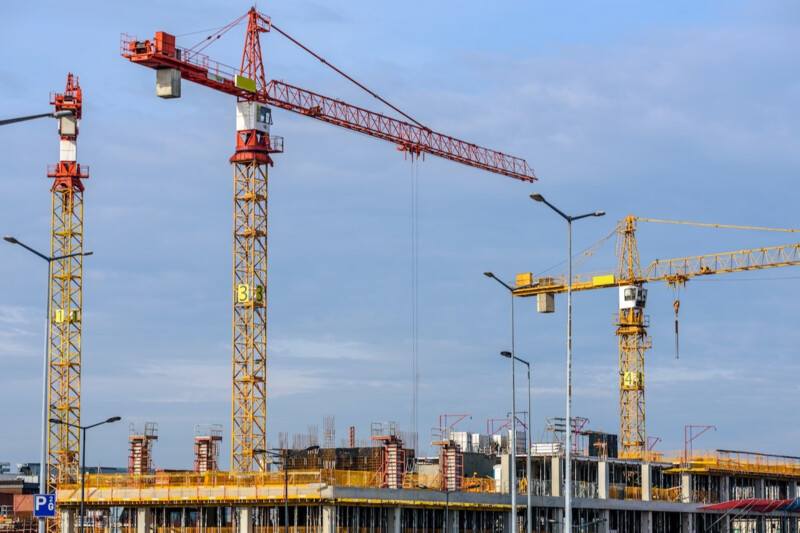Conformément à l’Accord de Paris, la France s’est engagée à atteindre la neutralité carbone à l’horizon 2050. Le secteur du BTP est également tenu à cet objectif, inscrit dans les lois Énergie Climat de 2019 et Climat et résilience de 2021. Les principaux acteurs du secteur déploient différentes stratégies pour réduire les gaz à effet de serre émis sur les chantiers de construction. Revue de détails des solutions propres ou « zéro émission » tentant de relever le défi.
Travaux publics : entre 500 et 900 milliards d’euros d’investissement pour atteindre la neutralité carbone
De la construction des bâtiments à leurs usages, le BTP produit plus des trois quarts des émissions de gaz à effet de serre en France. Atteindre la neutralité carbone à l’horizon 2050 s’annonce comme un défi majeur, que les secteurs du bâtiment et des travaux publics sont tenus de relever.
Conformément à la loi Climat et résilience de 2021, « chaque secteur fortement émetteur » de gaz à effet de serre doit établir, pour le 1er janvier 2023 au plus tard, une feuille de route multipartite coordonnant les actions mises en œuvre par le gouvernement, les représentants des filières économiques et les représentants des collectivités territoriales pour atteindre les objectifs fixés par la SNBC (Stratégie Nationale Bas-Carbone).
Après avoir mandaté 3 cabinets de conseil, la FNTP (Fédération nationale des travaux publics) a chiffré entre 500 et 900 milliards d’euros l’investissement nécessaire pour réduire son empreinte carbone d’ici à 2050. Si les chantiers de construction ne représentent en eux-mêmes que 3,5 % des émissions de gaz à effet de serre nationales, les solutions à mettre en œuvre pour atteindre la neutralité carbone s’annoncent complexes et coûteuses.
Pour commencer, les engins ne fonctionnant pas au gazole se vendent jusqu’à 3 fois plus cher, et le soutien financier des pouvoirs publics est, selon la FNTP, insuffisant. Mais les choses commencent à évoluer, comme le démontre le prêt de 130 millions d’euros obtenu en septembre par la société de location de matériels Loxam auprès de la Banque européenne d’investissement, qui va lui permettre d’acquérir et de louer de nouveaux engins alternatifs fonctionnant notamment à l’hydrogène.
Du biocarburant au béton bas-carbone : quelles innovations pour des chantiers propres ?
De son côté, TotalEnergies a établi un partenariat avec la société Saria, qui recycle des biodéchets, et sera chargée d’approvisionner en graisses animales et en huiles usagées alimentaires la raffinerie de Grandpuits. Celle-ci va être transformée en plateforme de biocarburants, et fournira notamment les aéroports parisiens, mais le biocarburant produit pourra aussi être utilisé pour alimenter des groupes électrogènes sur les chantiers.
La société Kiloutou mène quant à elle des tests sur ses véhicules de livraison pour qu’ils puissent fonctionner au gaz, sans émission de particules fines, ou à l’électricité, et prévoit de déployer des vélos cargos en ville pour les livraisons d’outillage.
Selon Olivier Colleau, le président exécutif de Kiloutou, le développement d’engins électriques se heurte actuellement à deux obstacles :
- d’une part, l’absence d’infrastructure de recharge sur les chantiers,
- d’autre part, le manque de formation à l’entretien et à la maintenance de ces engins.
Des solutions sont également recherchées pour généraliser l’utilisation de béton bas-carbone. Présent dans le béton standard, le ciment représente à lui seul 7 % des émissions mondiales de CO2. Vinci Construction affirme avoir développé ses propres solutions, permettant de réduire les émissions de gaz à effet de serre de 60 % sans perdre les propriétés initiales du béton.
Certaines sociétés, comme Kardham, préfèrent l’appellation « chantier propre » ou « chantier responsable » à celle de « chantier zéro émission ». Le groupe a élaboré sa propre charte, qui prend en compte toutes les émissions de gaz à effet de serre, du transport des matériaux à leur recyclage.
L’entreprise Colas, filiale du groupe Bouygues, a mis en place diverses mesures pour diminuer les émissions de CO2 sur les chantiers, comme les formations d’écoconduite visant à réduire la consommation de carburant ou l’utilisation d’un biocarburant à base de colza.
Selon la Fédération nationale des travaux publics, il faudra débourser au minimum 16,2 milliards d’euros par an d’ici à 2050 pour respecter les engagements de la Stratégie Nationale Bas-Carbone.
